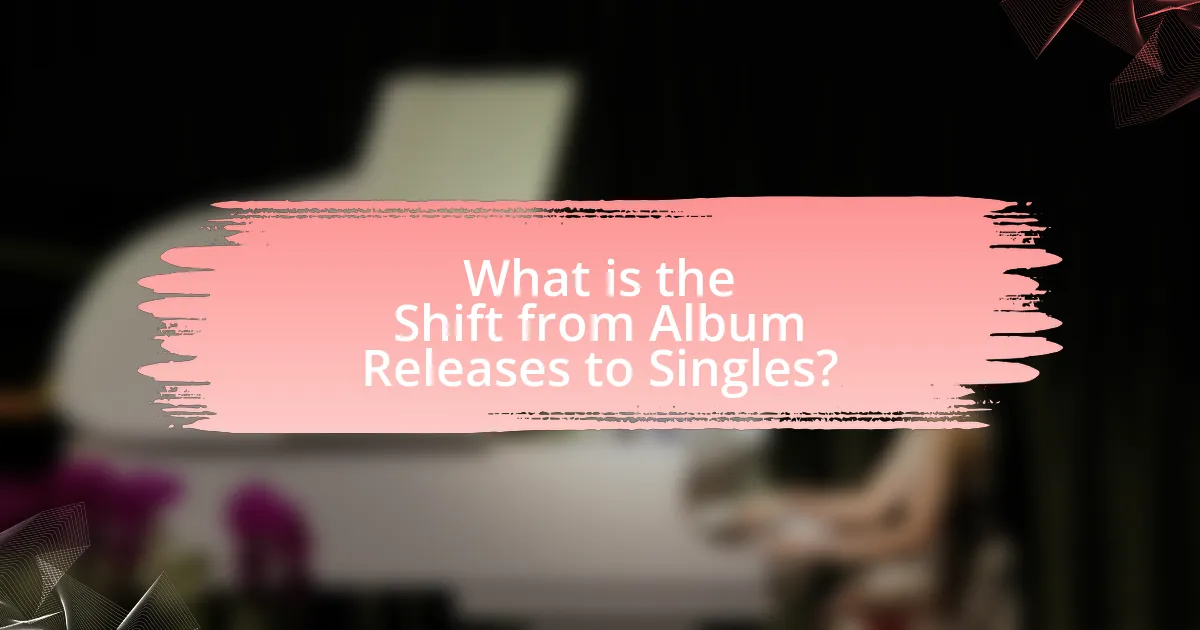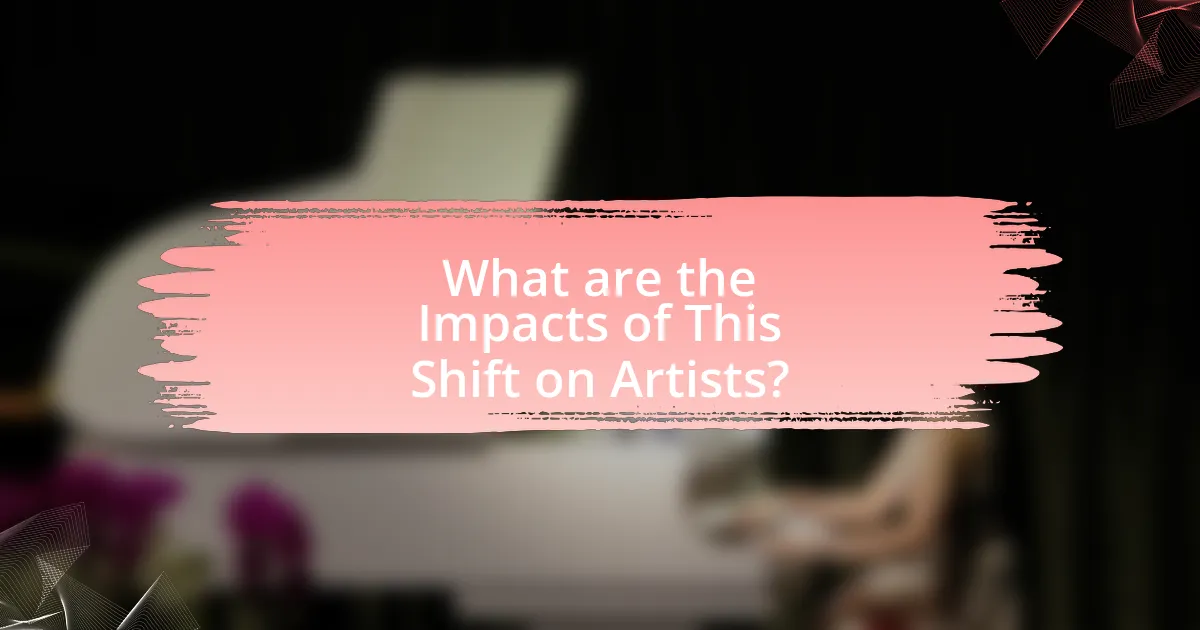The article examines the significant shift in the music industry from album releases to singles, driven by the rise of digital streaming platforms. It highlights how this trend reflects changing consumer behavior, with singles accounting for a substantial portion of global music consumption. The discussion includes the historical factors contributing to this shift, the financial implications for artists, and the impact on audience engagement. Additionally, it addresses the challenges faced by both artists and fans in a singles-driven market, as well as strategies for navigating this evolving landscape.

What is the Shift from Album Releases to Singles?
The shift from album releases to singles refers to the growing trend where artists prioritize releasing individual songs rather than full albums. This change is driven by the rise of digital streaming platforms, which favor shorter, more frequent releases that keep listeners engaged. According to a 2021 report by the International Federation of the Phonographic Industry, single-track releases accounted for 75% of global music consumption, highlighting the preference for singles over albums in the current music landscape. This shift allows artists to respond quickly to audience trends and maintain a consistent presence in the market.
How has the music industry evolved in terms of release formats?
The music industry has evolved from primarily album releases to a focus on singles. This shift has been driven by the rise of digital streaming platforms, which allow consumers to access individual tracks easily rather than entire albums. According to the Recording Industry Association of America (RIAA), in 2020, single track downloads accounted for 80% of digital music sales, highlighting the preference for singles over albums. Additionally, artists now often release singles to maintain engagement with their audience and adapt to shorter attention spans, as evidenced by the increasing frequency of single releases compared to traditional album cycles.
What historical factors contributed to the rise of singles over albums?
The rise of singles over albums can be attributed to several historical factors, including technological advancements, changes in consumer behavior, and shifts in the music industry’s marketing strategies. The introduction of the 45 RPM vinyl record in the 1940s allowed for the easy distribution of singles, making them more accessible to the public. Additionally, the advent of digital music and streaming platforms in the 2000s further accelerated this trend, as consumers began to favor the convenience of purchasing or streaming individual tracks rather than full albums. According to a 2019 report by the Recording Industry Association of America, single-track downloads accounted for a significant portion of music sales, reflecting a clear preference among listeners for singles. These factors collectively contributed to the dominance of singles in the music market.
How have technological advancements influenced this shift?
Technological advancements have significantly influenced the shift from album releases to singles by enabling easier access to music and altering consumption patterns. The rise of streaming platforms like Spotify and Apple Music has facilitated instant access to individual tracks, allowing listeners to curate personalized playlists rather than committing to full albums. According to a report by the Recording Industry Association of America (RIAA), streaming accounted for 83% of the U.S. music industry’s revenue in 2020, highlighting the dominance of single-track consumption. Additionally, social media platforms have empowered artists to promote singles directly to their audience, fostering a culture where frequent releases are more beneficial for engagement and visibility. This shift reflects a broader trend in consumer behavior, where immediacy and convenience are prioritized over traditional album formats.
Why are artists choosing to release singles instead of albums?
Artists are choosing to release singles instead of albums primarily due to the changing dynamics of music consumption and the digital landscape. The rise of streaming platforms has shifted listener behavior towards favoring individual tracks over full albums, as evidenced by data showing that singles often receive more plays and attention than album cuts. Additionally, releasing singles allows artists to maintain a consistent presence in the market, engage their audience more frequently, and adapt quickly to trends, which is crucial in a fast-paced industry. This strategy aligns with the need for artists to maximize their reach and relevance in an era where attention spans are shorter and competition is fierce.
What are the financial implications for artists in releasing singles?
Releasing singles can significantly impact an artist’s financial situation by providing immediate revenue opportunities and increasing streaming royalties. Singles often generate quicker cash flow compared to albums, as they can be released more frequently and capitalize on current trends. According to a report by the International Federation of the Phonographic Industry, streaming accounted for 62% of the global recorded music revenue in 2020, highlighting the importance of singles in driving income through platforms like Spotify and Apple Music. Additionally, singles can enhance an artist’s visibility, leading to increased merchandise sales and concert ticket sales, further contributing to their overall financial health.
How does audience engagement differ between singles and albums?
Audience engagement differs significantly between singles and albums, primarily due to the format and consumption habits associated with each. Singles typically generate immediate attention and engagement, as they are often released with promotional campaigns that focus on a specific track, leading to higher initial streaming numbers and social media buzz. In contrast, albums tend to foster deeper engagement over a longer period, as listeners explore multiple tracks and themes, often resulting in sustained discussions and analyses within fan communities.
Research indicates that singles can achieve up to 50% more streams in their first week compared to album tracks, highlighting the immediate impact of single releases. Additionally, albums often lead to increased fan loyalty and connection, as they provide a comprehensive narrative or artistic expression that singles alone may not convey.

What are the Impacts of This Shift on Artists?
The shift from album releases to singles significantly impacts artists by altering their revenue streams and promotional strategies. Artists now rely more on frequent single releases to maintain visibility and engagement with audiences, as streaming platforms favor consistent content over traditional album cycles. This change can lead to increased exposure and opportunities for collaboration, but it may also result in financial instability due to the lower per-stream payouts compared to album sales. According to a report by the Recording Industry Association of America, streaming accounted for 83% of the music industry’s revenue in 2020, emphasizing the importance of adapting to this new model for financial success.
How does releasing singles affect an artist’s creative process?
Releasing singles significantly impacts an artist’s creative process by allowing for more focused experimentation and immediate audience feedback. This approach enables artists to explore diverse musical styles and themes without the constraints of a full album, fostering innovation. For instance, artists like Billie Eilish have successfully utilized single releases to gauge listener reactions, which informs their subsequent creative decisions. This method not only enhances artistic flexibility but also aligns with the current music consumption trends, where listeners prefer bite-sized content.
What challenges do artists face when focusing on singles?
Artists face several challenges when focusing on singles, primarily including market saturation, limited storytelling, and financial constraints. Market saturation occurs because the digital landscape allows for a high volume of releases, making it difficult for individual singles to stand out. Limited storytelling arises as singles often lack the narrative depth that albums provide, which can hinder an artist’s ability to convey a cohesive message or artistic vision. Financial constraints also play a role, as producing and promoting multiple singles can be costly, and artists may struggle to allocate resources effectively without the financial backing that album sales traditionally provide.
How can artists leverage singles for better marketing opportunities?
Artists can leverage singles for better marketing opportunities by releasing them strategically to build anticipation and maintain audience engagement. By focusing on singles, artists can create a consistent flow of content, which keeps their fanbase active and engaged, as evidenced by the trend where artists like Drake and Ariana Grande release multiple singles throughout the year, leading to increased streaming numbers and chart performance. Additionally, singles allow for targeted marketing campaigns, such as social media promotions and collaborations with influencers, which can amplify reach and visibility. This approach is supported by data showing that singles often generate more immediate listener interest compared to full albums, as they cater to the current consumer preference for bite-sized content.
What are the potential risks for artists in this new landscape?
The potential risks for artists in the new landscape of shifting from album releases to singles include reduced revenue streams and diminished artistic expression. As artists focus on singles, they may experience a decline in overall album sales, which historically have provided a significant portion of their income. According to a report by the Recording Industry Association of America (RIAA), digital single sales have increased, but the overall revenue from albums has decreased, indicating a shift that may not fully compensate for lost income. Additionally, the emphasis on singles can lead to a lack of cohesive storytelling and thematic depth that albums traditionally offer, potentially alienating fans who appreciate the artistry of full-length projects.
How does the shift impact an artist’s long-term career trajectory?
The shift from album releases to singles significantly impacts an artist’s long-term career trajectory by altering their revenue streams and audience engagement strategies. This transition allows artists to release music more frequently, which can lead to increased visibility and a stronger connection with fans. For instance, artists who adopt a single-focused strategy can capitalize on streaming platforms, where singles often perform better than full albums, thus maximizing their earnings per release. Additionally, this approach enables artists to respond quickly to trends and audience preferences, fostering a more dynamic career path. Data from the Recording Industry Association of America indicates that streaming revenue has surpassed physical sales, underscoring the importance of adapting to this shift for sustained success in the music industry.
What role does fan feedback play in the success of singles?
Fan feedback plays a crucial role in the success of singles by directly influencing an artist’s promotional strategies and music production decisions. When fans express their preferences through social media, streaming platforms, and live interactions, artists can gauge which songs resonate most, allowing them to tailor their marketing efforts effectively. For instance, data from platforms like Spotify and Apple Music show that tracks with higher engagement rates often lead to increased streaming numbers and chart performance. Additionally, fan feedback can lead to adjustments in future releases, ensuring that artists remain aligned with audience expectations, ultimately driving the commercial success of their singles.

What does the Shift Mean for Fans?
The shift from album releases to singles means that fans will experience more frequent and varied content from their favorite artists. This change allows artists to release music more regularly, keeping fans engaged and excited about new material. For instance, instead of waiting months or years for a full album, fans can now anticipate singles that may drop unexpectedly, enhancing their connection to the artist’s evolving sound. Additionally, this trend reflects a broader industry shift towards digital consumption, where shorter formats are more easily shared and promoted on social media platforms, further increasing fan interaction and participation in the music experience.
How has the listening experience changed for fans?
The listening experience for fans has changed significantly due to the shift from album releases to singles. This transition allows fans to access new music more frequently, as artists now release individual tracks rather than waiting for an entire album. According to a report by Nielsen Music, in 2020, single track sales accounted for 80% of all music purchases, indicating a preference for this format among listeners. Additionally, streaming platforms like Spotify and Apple Music have further facilitated this change by promoting singles and playlists, enabling fans to discover and enjoy music in a more immediate and personalized manner.
What are the benefits of singles for fans compared to albums?
Singles provide fans with immediate access to new music, allowing them to engage with an artist’s latest work more frequently than waiting for an entire album release. This format caters to the fast-paced consumption habits of modern listeners, as evidenced by the rise of streaming platforms where singles often dominate playlists. Additionally, singles can create a more focused listening experience, highlighting specific tracks that may resonate more strongly with fans compared to the broader collection of songs found in albums. The trend towards singles has been supported by data showing that artists who release singles regularly can maintain higher visibility and engagement with their audience, as seen in the increased streaming numbers and social media interactions surrounding single releases.
How do singles influence fan engagement and loyalty?
Singles significantly enhance fan engagement and loyalty by providing frequent touchpoints for interaction. The release of singles allows artists to maintain a consistent presence in fans’ lives, fostering a sense of connection and anticipation. For instance, studies show that artists who release singles regularly can increase their streaming numbers and social media interactions, as fans are more likely to engage with new content. This ongoing engagement cultivates loyalty, as fans feel more invested in the artist’s journey and are more likely to support them through concert attendance and merchandise purchases.
What challenges do fans face in a singles-driven market?
Fans face several challenges in a singles-driven market, primarily the fragmentation of music consumption and the difficulty in connecting with artists. In a landscape where singles dominate, fans often miss the cohesive storytelling and artistic expression that albums provide, leading to a less immersive experience. Additionally, the rapid release of singles can overwhelm fans, making it challenging to keep up with new music and diminishing the anticipation that typically accompanies album releases. This shift also complicates the discovery of new artists, as singles may not showcase the full range of an artist’s talent, resulting in a narrower understanding of their work.
How does the abundance of singles affect music discovery for fans?
The abundance of singles enhances music discovery for fans by providing a continuous stream of new content, making it easier for listeners to explore diverse genres and artists. This frequent release schedule allows fans to engage with music more regularly, as they can discover new tracks without waiting for full albums. According to a report by Nielsen Music, in 2020, single track sales accounted for 80% of all music purchases, indicating a significant shift in consumer behavior towards singles. This trend not only increases exposure for emerging artists but also allows established musicians to maintain relevance in a fast-paced digital landscape.
What are the implications for fans who prefer albums over singles?
Fans who prefer albums over singles may experience a diminished sense of artistic cohesion and narrative depth in music consumption. Albums typically offer a curated collection of songs that convey a thematic journey, while the rise of singles often prioritizes immediate commercial appeal and streaming metrics. This shift can lead to fans missing out on the full artistic expression intended by the artist, as singles may not reflect the broader context of an album’s narrative or emotional arc. Additionally, fans who value the album format may find fewer opportunities to engage with artists in a meaningful way, as the industry increasingly focuses on single releases to drive quick engagement and revenue.
What strategies can fans adopt to navigate the singles landscape?
Fans can adopt several strategies to effectively navigate the singles landscape. First, they should actively follow artists on social media platforms to stay updated on new releases and promotional events. This engagement allows fans to receive real-time notifications about singles, enhancing their connection to the music. Additionally, fans can utilize streaming services that offer personalized playlists and recommendations based on listening habits, ensuring they discover new singles that align with their tastes.
Moreover, participating in online music communities and forums can provide fans with insights and discussions about upcoming singles, fostering a sense of community and shared enthusiasm. Engaging with music blogs and websites that focus on singles can also help fans identify trends and emerging artists. These strategies collectively empower fans to remain informed and connected in a rapidly evolving music landscape that increasingly prioritizes singles over traditional album releases.
How can fans support their favorite artists in a singles-focused environment?
Fans can support their favorite artists in a singles-focused environment by actively streaming and purchasing their singles. This direct financial support is crucial, as streaming platforms often pay artists based on the number of streams, making each listen valuable. Additionally, fans can promote the singles on social media, increasing visibility and engagement, which can lead to higher chart placements. According to the Recording Industry Association of America, streaming accounted for 83% of the music industry’s revenue in 2020, highlighting the importance of fan engagement in this format. By attending live performances and purchasing merchandise, fans further contribute to the artists’ success in a landscape that prioritizes singles over albums.
What platforms are best for discovering new singles from artists?
Streaming platforms such as Spotify, Apple Music, and SoundCloud are the best for discovering new singles from artists. Spotify offers curated playlists like “New Music Friday” and personalized recommendations based on listening habits, making it easy for users to find fresh tracks. Apple Music features a similar approach with its “New Music Daily” playlist and exclusive releases. SoundCloud allows independent artists to upload their singles directly, providing a platform for emerging talent to reach listeners. These platforms collectively account for a significant portion of music consumption, with Spotify alone boasting over 500 million users as of 2023, highlighting their effectiveness in music discovery.


